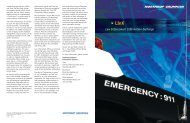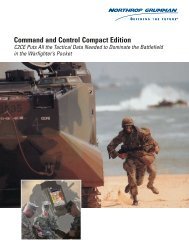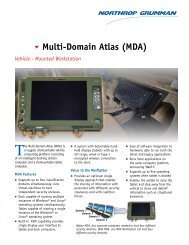Pythagoras: A New Agent-based Simulation System - Northrop ...
Pythagoras: A New Agent-based Simulation System - Northrop ...
Pythagoras: A New Agent-based Simulation System - Northrop ...
Create successful ePaper yourself
Turn your PDF publications into a flip-book with our unique Google optimized e-Paper software.
<strong>Pythagoras</strong>: A <strong>New</strong> <strong>Agent</strong>-<strong>based</strong> <strong>Simulation</strong> <strong>System</strong><br />
Figure 2. Three alternative degrees of individuality<br />
In each of the three cases illustrated in Figure 2, the midpoint for the behavior variable<br />
is 5. That value might, for example, represent the minimum number of enemies from<br />
which an agent would retreat. The red uniform distribution represents a firm, homogeneous<br />
behavior variable, for which the range is ±1 around the midpoint of 5. The green<br />
uniform distribution depicts a softer behavior variable, for which the range is ±2 around<br />
the midpoint, indicating that the value of the behavior variable could lie in the range of 3<br />
to 7. The loosest of the three definitions for the behavior variable is described by the<br />
blue uniform distribution. In that case, the range is ±4 around the midpoint, and values<br />
for the behavior variable could range from a low of 1 to a high of 9. Individual behavior<br />
drawn from such a loose distribution would be quite heterogeneous.<br />
<strong>Agent</strong> Desires to Move<br />
In <strong>Pythagoras</strong>, agents can be assigned movement desires, from the possible selections<br />
listed in Table 1, to determine their movement paths as a scenario unfolds. During each<br />
decision cycle, an agent establishes which desires are active (e.g., too far from a leader),<br />
and, if the sum of the desires to move exceeds a user-determined threshold, the agent<br />
then uses the strengths of the desires to determine a direction of movement. If multiple<br />
desires are active, they can be adjudicated at the user’s discretion by one of four<br />
alternative methods:<br />
• Through vector algebra, using direction weighted by desire<br />
• By priority (i.e., the strongest desire)<br />
• At random, with the relative weight of each desire determining its probability of<br />
selection<br />
• By applying vector algebra for only the two strongest desires<br />
Although the list of existing desires is small, it can be used to represent a variety of<br />
behaviors.<br />
48<br />
Probability<br />
0.6<br />
0.5<br />
0.4<br />
0.3<br />
0.2<br />
0.1<br />
0<br />
0<br />
2<br />
4 6<br />
Decision Threshold<br />
Common decision threshold = 5<br />
Firm/low individuality range ±1 around the threshold<br />
Soft/medium individuality range ±2 around the threshold<br />
Loose/high individuality range ±4 around the threshold<br />
Technology Review Journal • Spring/Summer 2003<br />
8<br />
10<br />
Firm<br />
Soft<br />
Loose






